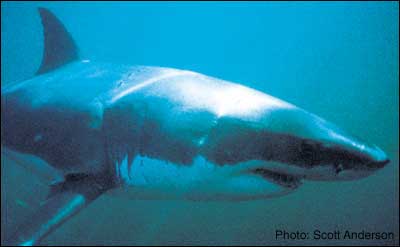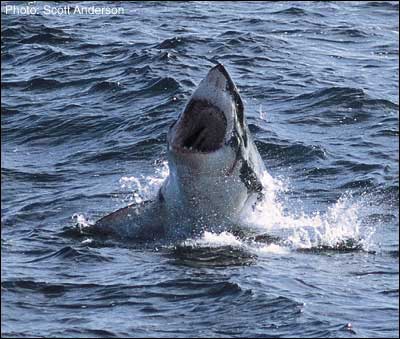The media portrays white sharks as cold-blooded killing machines out to attack anything resembling food. The real story is that white sharks are wary, elusive, selective predators
that only occasionally attack people--and it's by mistake when they do. Most people survive the attack and, on average, there are only one or two attacks on people each year on the U.S. West Coast.
Driving your car to your favorite surfing spot is statistically way more dangerous than going surfing at your local beach break.

After 12 years of white shark research, I've amassed the following facts: there is a healthy population of white sharks off the West Coast of the United States, though no one knows for sure the actual
numbers. I see many of the same sharks repeatedly (identified by their natural and acquired markings) year after year. The white shark is one of the few shark species that is warm-blooded and gives
birth--up to nine pups per litter. Being at the top of the marine food chain, they are an apex predator and a protected species in California. As a white shark researcher, it's my responsibility to share what
I've learned about these magnificent predators with the people who are most at risk of attack: surfers and the others who spend time in the ocean.
Part of my ongoing research concerns white shark vision and their ability to discriminate between different sizes and shapes. I've used surfboards as part of a visual discrimination study, where I looked at
how the sharks use their vision and what stimulates them to attack. (No baiting has ever been used in my research; the sharks are not being taught to attack the board. If anything, they learn not to.)
Surfboards are typically the same size and general shape of seals and sea lions, the white shark's main prey. Put a surfer on the board, and the shape now includes flippers. From my studies I've found
that a longboard is less likely to be attacked. While a short (5' 9"), fat swallowtail, which closely resembles a seal, is more likely to be attacked. In this study, I also put out a square with the same total
surface area as a shortboard. Since the square was close in size compared to the board, the sharks investigated by circling the object but never bit it. This shows how important both size and shape are
to a white shark searching for prey. The shark is not out to attack a human but will mistakenly attack a board with a human pilot because it closely resembles a seal from below.
When searching for prey, these animals tend to be sneaky, staying near the bottom and out of sight. They come and go from hunting areas seasonally, seeking prey nearer to shore. The sharks tack
back and forth, in and out, studying the surface silhouettes. The key to success for the shark is to ambush a seal or sea lion. Once visual contact is made, it takes a white shark only two to three seconds
to close the distance between itself and its prey. Attacks are short and violent, coming from below and lasting just a few seconds--the intent of the shark is to kill its prey with the initial bite. Most attacks in
California aren't fatal, and nearly all victims are bitten only once.

The scenario with a surfer is quite different. First, when a white shark attacks a surfboard it has made a mistake. The shark almost always leaves at this point. Second, the surfer and board are two separate
objects and the board usually takes the brunt of the hit, so the surfer, despite injuries, can possibly get back on and paddle to shore. After such an attack the most important thing to do is to stop or
contain any bleeding as much as possible.
Eric Larson, who was attacked by a white shark in '91, provides a good example of how to survive an attack. Following the attack, as Eric was paddling toward shore, he was able to apply enough pressure
to control his own bleeding. When he got to the beach, his knowledge of first aid and anatomy allowed him to instruct others exactly where and how to put pressure on his main arteries to further contain
the bleeding. This knowledge saved his life (see San Francisco Chronicle, 7/4/91, page 1).
Lastly, the incidence of white shark attacks on surfers on the West Coast are very few. California averages about two attacks per year, with a fatality once every five years. Statistically speaking, more
people are killed by pigs in Iowa.
WHITE SHARK SURVIVAL GUIDE
1. Don't surf at places with known histories of white shark sightings or attacks, and avoid spots with seal colonies and deep water.
2. Never surf alone. One more person in the water cuts your odds of being attacked in half.
3. Carry a radio or cell phone at remote spots.
4. Know first aid, especially how to stop bleeding and how to deal with shock. By Scott Anderson "I'M NOT BAD, JUST MISUNDERSTOOD." DON'T BE A DUMMY.